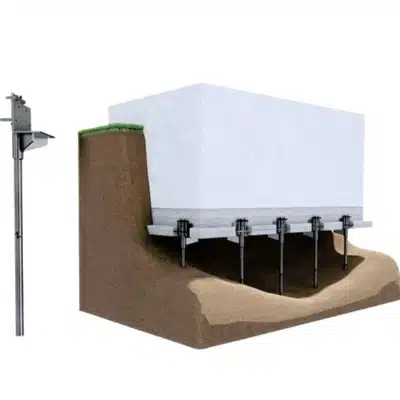Foundation Cracks
Foundation cracks can be unsightly, but they can also be a sign of deeper issues with your crawl space. In fact, they are one of the most common indicators of crawl space problems.
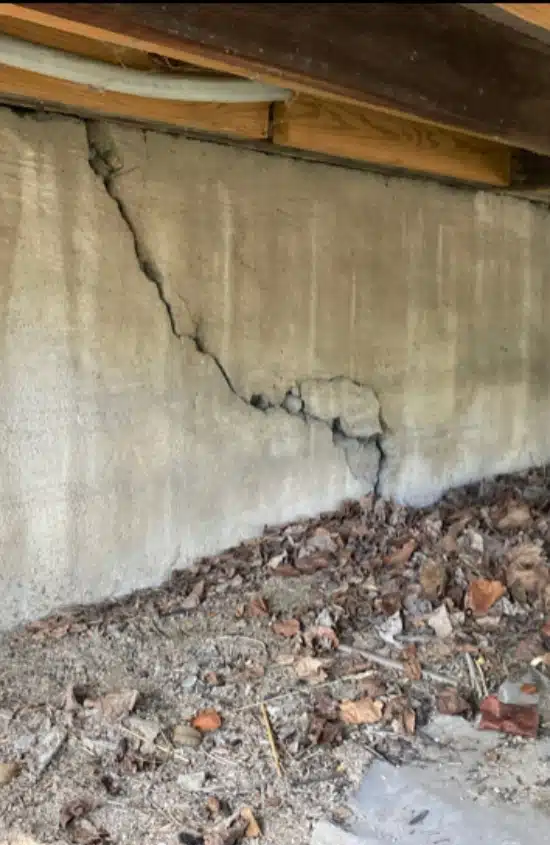
Foundation Crack Repair in Northern Virginia, Shenandoah Valley, North Central Virginia, and West Virginia
Foundation cracks are a clear indication of underlying crawl space issues. They can be a result of various factors, including soil expansion, poor drainage, poor construction, soil movement, water damage, or foundation settling. If left untreated, these gaps can lead to more severe and expensive foundation issues. The earlier you detect foundation cracks, the better chance of avoiding costly repairs.
If you notice any cracks on your foundation walls, floors, or ceilings, it is essential to take action immediately to prevent further damage.
At LUX Foundation Solutions, we understand the significance of a healthy foundation. Our experienced team can assess cracks in your foundation and determine the root cause of the problem. We offer a range of solutions to address crawl space issues, including encapsulation, waterproofing, and foundation repairs. Contact us today to schedule a free estimate and learn more about our services.
Do These Signs of Foundation Cracks Seem Familiar?
The symptoms
Cracks in the foundation can appear in a variety of sizes and shapes, depending on the underlying issue. Some common signs of foundation cracks include:
- Vertical cracks in walls
- Diagonal cracks at the corners of windows or doors
- Stair-step cracks in brickwork
- Cracking or crumbling foundation
- Uneven floors or sagging ceilings
- Doors or windows that no longer close properly
If you notice any of these issues in your home, it’s important to have an expert assess your foundation and crawl space. Our team at LUX Foundation Solutions can help identify the underlying cause and provide the necessary repairs to ensure that your home is safe and stable.

Vertical cracks
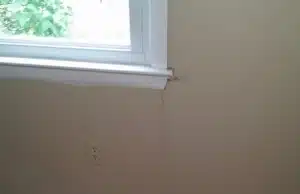
Cracks near window

Stair-step cracks

Crumbling foundation

Unlevel floors
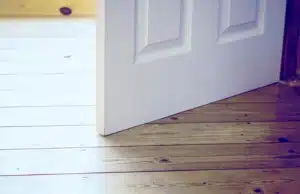
Sticking door
What Causes Foundation Cracks?
Foundation cracks can be caused by a variety of factors, including

Natural Settlement
Foundation cracks often result from the natural settling of a house on its foundation over time. This process occurs as the weight of the structure gradually compresses the soil beneath it.
As the soil compacts, it can cause stress on the foundation, leading to gaps. While some degree of settling is normal, excessive or uneven settling can create significant foundation issues and crawl space problems.

Shifting Soil
The composition and condition of the soil beneath a foundation play a crucial role in its stability. Soil that expands and contracts due to moisture fluctuations can exert pressure on the foundation. When clay-rich soils absorb water, swell or release water, and shrink, it can lead to movement and gaps. Soil movement can be particularly problematic in regions with extreme weather changes.

Hydrostatic Pressure
Hydrostatic pressure occurs when water in the soil exerts force against the foundation walls. Poor drainage or heavy rainfall can cause water to accumulate around the foundation, increasing pressure on the walls.
Over time, this constant pressure can result in gaps as the walls struggle to withstand the hydraulic force. This is a common issue in crawl spaces, where water can accumulate unnoticed.

Poor Drainage and Water Damage
Inadequate drainage systems or water damage can significantly contribute to crawl space problems and foundation cracks. When water is not directed away from the foundation properly, it can saturate the soil and weaken its integrity. Water can seep into cracks, freeze, and expand, causing further damage and widening of existing gaps.

Poor Construction or Design
Foundations that were poorly constructed or designed may be more susceptible to cracking. Insufficient reinforcing, the use of subpar materials, or improper construction techniques can weaken the foundation’s structural integrity. These issues can become apparent as cracks develop over time, compromising the crawl space and the entire structure’s stability.
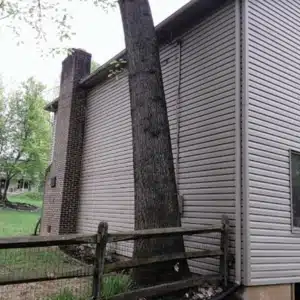
Environmental and Climate Changes
Regions prone to seismic activity may experience foundation movement and cracking during earthquakes. Additionally, extreme temperature fluctuations can cause materials to expand and contract, leading to stress on the foundation walls. Over time, these cyclical changes can result in gaps and crawl space problems.
Regardless of the cause, it’s important to address foundation cracks as soon as they appear. Ignoring the problem can lead to further damage and a more costly repair process. LUX Foundation Solutions offers a range of solutions to address foundation cracks and crawl space issues, including encapsulation, waterproofing, and foundation repair.
Our Solutions
A sloping floor in your crawl space can indicate moisture and foundation issues. Our recommended solution is a combination approach involving crawl space encapsulation and crawl space stabilizer posts.
Crawl space encapsulation involves covering the walls and floors of your crawl space with a thick, waterproof barrier. This helps to prevent moisture and humidity from seeping through the walls and floorboards, which can cause wood to rot and degrade over time. Encapsulation also helps keep pests and rodents out of your crawl space.
Crawl space stabilizer posts, on the other hand, are designed to reinforce and level your crawl space floor. Stabilizer posts are installed to distribute the weight of your home more evenly, reducing the likelihood of a sloping, sagging, or buckling floor. This is especially important if your foundation walls have cracks or damage, as water can seep through and erode the soil beneath your home, causing your foundation to settle unevenly.
The installation involves thoroughly inspecting your crawl space foundation to assess the extent of the moisture and/or foundation damage. Once the problem has been diagnosed, our team will recommend a customized solution that addresses the specific needs of your home. Depending on the extent of the damage, the installation process may involve excavation, leveling, sealing, and reinforcing the crawl space floor joists or foundation. Our team of experts will work quickly and efficiently to complete the job as soon as possible, with minimal disruption to your daily routine.
At LUX Foundation Solutions, we understand that dealing with crawl space moisture and foundation issues can be overwhelming. That’s why we’re here to provide you with the support and guidance you need to make informed decisions about your home. Our team of experts is committed to delivering the highest quality workmanship, so you can trust us to handle your crawl space problems with care and professionalism.
Yes, you should definitely consider fixing severe cracks and signs of bowing in your crawl space foundation. These are signs of foundation issues that can lead to structural damage if left unaddressed. One effective solution that LUX Foundation Solutions recommends is the installation of wall anchors.
Wall anchors are a trusted solution for stabilizing and strengthening foundations. They work by attaching to the interior walls of your crawl space and providing lateral support to resist the external pressure that causes them to bow or crack. Wall anchors consist of an anchor plate, a steel rod, and a wall plate that are all connected by a pivot to allow for proper tensioning.
The installation process for wall anchors involves digging small holes outside of your home to access the foundation walls. The anchor plate is then installed in the hole and connected to the steel rod, which is then driven through the foundation wall and into the soil outside. The wall plate is then attached to the rod, and tension is applied to the anchor by tightening the rod, which pulls the wall back into its original position.
Installing wall anchors is a reliable and cost-effective way of repairing foundation problems in your crawl space. By choosing LUX Foundation Solutions, you can trust that our team of experts will provide you with high-quality work and excellent customer service. Don’t hesitate to contact us today for a free estimate and more information on how we can help you with your crawl space foundation problems.
If you have limited backyard space and your crawl space foundation is showing cracks and bowing, LUX Foundation Solutions recommends the installation of push piers.
Push piers are designed to repair your foundation by transferring the structure’s weight to stable soil, or bedrock, deep beneath the surface. This solution is ideal for limited space situations because it only requires a small area for installation and can be performed quickly.
We use the highest quality push pier products that are designed to last for a long time and prevent your foundation from further damage.
The installation process for push piers typically involves excavating small holes around the perimeter of your foundation. The steel tube piers are then driven through these holes and attached to your foundation to provide lasting support. It can also be adjusted to lift and level your foundation back into its original position.
The process is minimally invasive and typically takes just a few days to complete, depending on the size of your home and the extent of the damage.
By choosing LUX foundation solutions for your push pier installation, you can be confident in our years of experience and dedication to quality workmanship. Our team of experts will work closely with you to assess your foundation needs and develop a custom solution that meets your unique requirements. Contact us today to learn more about how push piers can help protect your home’s foundation.
Free Foundation Crack Repair Estimate in Northern Virginia, Shenandoah Valley, North Central Virginia, and West Virginia
Dealing with foundation cracks is a concern for any homeowner. Whether they indicate a severe structural issue or are merely cosmetic, it’s crucial to handle them carefully when they appear in your crawl space foundation.
Experts at LUX Foundation Solutions can assess your crawl space and foundation to determine the root cause of the issue and offer personalized solutions. With our help, you can keep your home safe, secure, and fully functional for years to come.
Don’t ignore cracks in your foundation – contact our team today at 540-508-8587 or fill out our online estimate request form to schedule a free, on-site estimate. We offer crawl space repair services in Northern Virginia, Shenandoah Valley, North Central Virginia, West Virginia, and surrounding areas.
Request a free Estimate
FAQ's
The seriousness of a foundation crack depends on several factors, including the width, length, and location of the crack, as well as the underlying cause. Here are some general guidelines to help you determine if a foundation crack is serious:
- Width of the Crack:
Hairline cracks (less than 1/16 inch wide): These are typically not considered serious and are often the result of minor settling. However, it’s essential to monitor them for any changes.
Cracks between 1/16 inch and 1/4 inch wide: While still relatively small, these gaps should be inspected, especially if they are growing or accompanied by other signs of foundation issues.
Cracks wider than 1/4 inch: Cracks of this width are generally more concerning and may indicate a structural problem. They should be addressed promptly. - Length of the Crack:
Short cracks: Cracks that are only a few inches in length are less likely to be a cause for immediate concern.
Long cracks: Cracks that extend several feet or across multiple walls are more severe and should be examined by a professional. - Location of the Crack:
Cracks near corners or intersections of walls: These are often more critical as they can indicate stress points in the foundation.
Horizontal cracks: Horizontal cracks are typically more concerning than vertical ones because they can signify bowing or shifting walls.
Cracks near doors and windows: Gaps in these areas may suggest issues with the foundation settling or shifting. - Other Signs and Symptoms:
If the crack is accompanied by other signs of foundation problems, such as uneven floors, sticking doors or windows, or crawl space water intrusion, it’s more likely to be a serious issue. - Rate of Change:
Monitoring the crack over time is essential. If you notice that the gap is growing wider or longer, it clearly indicates that the problem is worsening and should be addressed urgently. - Underlying Cause:
The cause of the crack is also a critical factor. Cracks due to natural settling or minor shifts may be less serious than those caused by significant soil movement, hydrostatic pressure, or other structural issues.
It’s generally advisable to err on the side of caution and seek expert advice when in doubt, as prompt action can prevent more significant and costly repairs in the future.
As a homeowner, it’s essential to keep a close eye on the condition of your home’s foundation, as it plays a critical role in the structural integrity of your house. Foundation cracks can be a cause for concern, but not all are created equal. Here’s what you need to know about when to be worried:
- Size Matters: The size of the crack is a crucial factor in determining whether you should be concerned. Small hairline cracks (typically less than 1/8 inch wide) are common and often not a cause for alarm. These are usually a result of the natural settling of your home and can be easily sealed to prevent water intrusion.
- Vertical vs. Horizontal: The direction of the crack is also significant. Vertical cracks are generally less concerning than horizontal ones. They are often caused by shrinkage or minor settlement, while horizontal cracks can indicate a more serious issue with the foundation’s structural integrity.
- Width of Cracks: If a crack is wider than 1/4 inch, it’s a reason for concern. Wide gaps can allow moisture to penetrate the foundation, potentially leading to water damage or even structural problems. A professional should inspect these.
- Multiple Cracks: The presence of numerous cracks, especially if they appear suddenly, can be a red flag. It could indicate ongoing movement or pressure on the foundation, which warrants immediate attention.
- Associated Symptoms: Keep an eye out for other signs such as sticking doors or windows, uneven floors, or visible gaps between walls and ceilings. These symptoms can accompany foundation issues and should prompt further investigation.
Not all foundation cracks are cause for immediate alarm. However, monitoring them regularly and taking action if you notice any of the concerning signs mentioned above is essential. Prompt attention to foundation issues can save you from costly repairs in the long run and help ensure the safety and stability of your home.
When in doubt, consulting with a foundation specialist is always a good idea. They can assess the severity of the cracks, identify the underlying causes, and recommend appropriate repairs.
Different types of foundation cracks require your attention as they can have various repercussions in your space. To address them effectively, it is important to determine the specific type of crack you are dealing with.
Here’s some information to help you understand the different types.
Horizontal Foundation Cracks
Horizontal cracks run parallel to the ground and are often a cause for concern. They typically indicate lateral pressure or soil movement against the foundation wall. These gaps can result from poor drainage, excessive soil pressure, or water infiltration. Horizontal cracks should be inspected by a professional, as they can signify structural issues that require immediate attention.
Vertical Foundation Cracks:
Vertical cracks run straight up and down, among the most common types of cracks. They often result from the normal settling of a house. However, if a vertical gap widens or shows signs of displacement, it should be monitored and, if necessary, repaired to prevent further damage.
Hairline Foundation Cracks:
Hairline cracks are tiny, shallow, and typically less than 1/16 inch wide. They are common in concrete and often form as the material cures. While these are generally not a significant concern, they should be periodically monitored for any widening or lengthening.
Stair Step Foundation Cracks:
Stair step cracks resemble a staircase pattern and are often seen in brick or block foundations. They can indicate differential settling or structural problems. The severity of these gaps depends on their width and extent, and they should be inspected by a professional.
Diagonal Foundation Cracks:
Diagonal cracks form at an angle, typically 45 degrees, and may result from differential settling or structural stress. The seriousness depends on their size and location. It’s important to assess them carefully to determine the appropriate action.
Shrinkage Foundation Cracks:
Shrinkage cracks occur during the curing process of concrete and are typically small, thin gaps. They are a common occurrence in newly poured foundations and are generally not a cause for concern unless they become more extensive over time.
Wet Foundation Cracks:
Wet foundation cracks are gaps that allow water to infiltrate the foundation. These cracks can lead to moisture problems, including mold growth and structural deterioration. Sealing and repairing is essential to prevent further water damage.
It’s crucial for homeowners to regularly inspect their foundations for any signs of cracking or damage. While not all gaps require immediate action, monitoring them and seeking professional advice when needed can help prevent more significant issues down the line.
If you notice any of these cracks, reach out to LUX Foundation Solutions for a complimentary inspection to address the issue promptly for your home’s long-term stability and safety.
If you have cracks in your foundation, they will require professional assistance for proper repair. Attempting a DIY project is not advisable.
Here’s what is needed to fix foundation cracks.
- Addressing the root cause
Foundation cracks should not be treated as a DIY project due to the need to identify and resolve underlying issues. Simply filling the gaps with grout without understanding the cause is insufficient. It is crucial to determine the root cause, such as excess water in the crawl space, hydrostatic pressure, or uneven settling of the house.
The only way to accurately diagnose and address the gaps is to consult an expert who can evaluate both the foundation and the entire crawl space. Contact LUX Foundation Solutions today to schedule a free on-site estimate. - Encapsulating the crawl space
If moisture is an ongoing issue in your crawl space, it is important to consider encapsulation. This may involve closing open crawl space vents, laying down a vapor barrier, or insulating cold water pipes.
Crawl space encapsulation plays a vital role in home repair, especially for dirt crawl spaces. Excess moisture can have serious long-term implications for your family’s health and the overall condition of the space.
Attempting crawl space encapsulation on your own is not recommended. DIY homeowners often overlook crucial steps that an expert would identify. Instead, consult with a LUX expert team who can provide assistance and guidance. - Foundation Maintenance
Maintaining the health of your foundation is of vital importance after all the efforts you put into establishing a strong base. Preventing recurring problems requires taking necessary steps, such as using a dehumidifier or implementing long-term changes. Numerous methods can be employed to keep your crawl space in good condition.
To ensure proper maintenance, it is recommended to consult with a professional who possesses the necessary expertise. Reach out to a LUX expert today to explore more options for preserving the integrity of your foundation.



